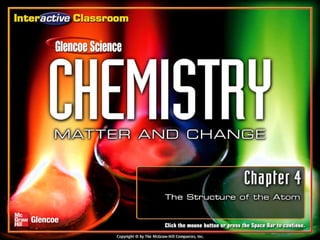Cmc chapter 04
•Transferir como PPT, PDF•
7 gostaram•2,513 visualizações
Denunciar
Compartilhar
Denunciar
Compartilhar

Recomendados
Recomendados
Mais conteúdo relacionado
Mais procurados
Mais procurados (20)
Chapter - 3, Atoms And Molecules, (Mole Concept) Science, Class 9

Chapter - 3, Atoms And Molecules, (Mole Concept) Science, Class 9
Destaque
Destaque (20)
Semelhante a Cmc chapter 04
Semelhante a Cmc chapter 04 (20)
Mais de Jane Hamze
Mais de Jane Hamze (12)
Último
Mehran University Newsletter is a Quarterly Publication from Public Relations OfficeMehran University Newsletter Vol-X, Issue-I, 2024

Mehran University Newsletter Vol-X, Issue-I, 2024Mehran University of Engineering & Technology, Jamshoro
This presentation was provided by William Mattingly of the Smithsonian Institution, during the third segment of the NISO training series "AI & Prompt Design." Session Three: Beginning Conversations, was held on April 18, 2024.Mattingly "AI & Prompt Design: The Basics of Prompt Design"

Mattingly "AI & Prompt Design: The Basics of Prompt Design"National Information Standards Organization (NISO)
APM Welcome
Tuesday 30 April 2024
APM North West Network Conference, Synergies Across Sectors
Presented by:
Professor Adam Boddison OBE, Chief Executive Officer, APM
Conference overview:
https://www.apm.org.uk/community/apm-north-west-branch-conference/
Content description:
APM welcome from CEO
The main conference objective was to promote the Project Management profession with interaction between project practitioners, APM Corporate members, current project management students, academia and all who have an interest in projects.APM Welcome, APM North West Network Conference, Synergies Across Sectors

APM Welcome, APM North West Network Conference, Synergies Across SectorsAssociation for Project Management
Último (20)
ICT Role in 21st Century Education & its Challenges.pptx

ICT Role in 21st Century Education & its Challenges.pptx
Russian Escort Service in Delhi 11k Hotel Foreigner Russian Call Girls in Delhi

Russian Escort Service in Delhi 11k Hotel Foreigner Russian Call Girls in Delhi
Web & Social Media Analytics Previous Year Question Paper.pdf

Web & Social Media Analytics Previous Year Question Paper.pdf
Measures of Central Tendency: Mean, Median and Mode

Measures of Central Tendency: Mean, Median and Mode
Seal of Good Local Governance (SGLG) 2024Final.pptx

Seal of Good Local Governance (SGLG) 2024Final.pptx
Unit-V; Pricing (Pharma Marketing Management).pptx

Unit-V; Pricing (Pharma Marketing Management).pptx
Beyond the EU: DORA and NIS 2 Directive's Global Impact

Beyond the EU: DORA and NIS 2 Directive's Global Impact
Basic Civil Engineering first year Notes- Chapter 4 Building.pptx

Basic Civil Engineering first year Notes- Chapter 4 Building.pptx
Presentation by Andreas Schleicher Tackling the School Absenteeism Crisis 30 ...

Presentation by Andreas Schleicher Tackling the School Absenteeism Crisis 30 ...
Mattingly "AI & Prompt Design: The Basics of Prompt Design"

Mattingly "AI & Prompt Design: The Basics of Prompt Design"
APM Welcome, APM North West Network Conference, Synergies Across Sectors

APM Welcome, APM North West Network Conference, Synergies Across Sectors
Cmc chapter 04
- 2. Chapter Menu The Structure of the Atom Section 4.1 Early Ideas About Matter Section 4.2 Defining the Atom Section 4.3 How Atoms Differ Section 4.4 Unstable Nuclei and Radioactive Decay Exit Click a hyperlink or folder tab to view the corresponding slides.
- 4. Section 4-1 Section 4.1 Early Ideas About Matter (cont.) Dalton's atomic theory The ancient Greeks tried to explain matter, but the scientific study of the atom began with John Dalton in the early 1800's.
- 7. Section 4-1 Greek Philosophers (cont.)
- 9. Section 4-1 Greek Philosophers (cont.)
- 12. End of Section 4-1
- 14. Section 4-2 Section 4.2 Defining the Atom (cont.) atom cathode ray electron nucleus proton neutron An atom is made of a nucleus containing protons and neutrons; electrons move around the nucleus.
- 32. End of Section 4-2
- 34. Section 4-3 Section 4.3 How Atoms Differ (cont.) atomic number isotopes mass number The number of protons and the mass number define the type of atom. periodic table: a chart that organizes all known elements into a grid of horizontal rows (periods) and vertical columns (groups or families) arranged by increasing atomic number atomic mass unit (amu) atomic mass
- 38. Section 4-3 Isotopes and Mass Number (cont.)
- 43. End of Section 4-3
- 45. Section 4-4 Section 4.4 Unstable Nuclei and Radioactive Decay (cont.) radioactivity radiation nuclear reaction radioactive decay alpha radiation Unstable atoms emit radiation to gain stability. alpha particle nuclear equation beta radiation beta particle gamma rays
- 51. Section 4-4 Radioactive Decay (cont.)
- 56. End of Section 4-4
- 57. Resources Menu Chemistry Online Study Guide Chapter Assessment Standardized Test Practice Image Bank Concepts in Motion
- 72. IB Menu Click on an image to enlarge.
- 73. IB 1
- 74. IB 2
- 75. IB 3
- 76. IB 4
- 77. IB 5
- 78. IB 6
- 79. IB 7
- 80. IB 8
- 81. IB 9
- 82. IB 10
- 83. IB 11
- 84. IB 12
- 85. IB 13
- 86. IB 14
- 87. IB 15
- 88. IB 16
- 89. IB 17
- 90. CIM Table 4.3 Properties of Subatomic Particles Figure 4.12 Rutherford's Experiment Figure 4.14 Features of an Atom Figure 4.21 Types of Radiation
- 91. Help Click any of the background top tabs to display the respective folder. Within the Chapter Outline, clicking a section tab on the right side of the screen will bring you to the first slide in each respective section. Simple navigation buttons will allow you to progress to the next slide or the previous slide. The “Return” button will allow you to return to the slide that you were viewing when you clicked either the Resources or Help tab. The Chapter Resources Menu will allow you to access chapter specific resources from the Chapter Menu or any Chapter Outline slide. From within any feature, click the Resources tab to return to this slide. To exit the presentation, click the Exit button on the Chapter Menu slide or hit Escape [Esc] on your keyboards while viewing any Chapter Outline slide.
- 92. End of Custom Shows This slide is intentionally blank.